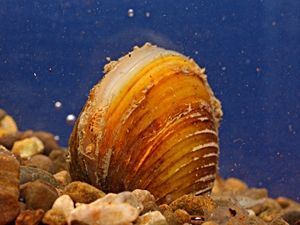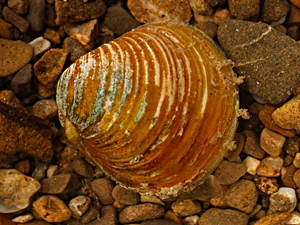
Asian clam (Corbicula fluminea).
Picture: © Alexander Mrkvicka, Vienna (mrkvicka.at).
 Asian clam (Corbicula fluminea). Picture: © Alexander Mrkvicka, Vienna (mrkvicka.at). |
Description: Asian clams, also referred to as good luck clams, have quite thick shells of a roundish triangular form. Their shell surface is ribbed and furrowed concentrically. Each shell has three main teeth separated by deep grooves. The lateral teeth are quite long and ribbed laterally. There are two species in Europe, Corbicula fluminea and Corbicula fluminalis, which are quite difficult to tell apart. It is, however, assumed, that about 90% of the Asian clams found belong to the species Corbicula fluminea.
 Asian clam (Corbicula fluminea) from the river Danube. Picture: © Alexander Mrkvicka, Vienna (mrkvicka.at). |
Dimensions: H: 20 - 40 mm; W: 20 - 40 mm.
Habitat and Distribution: Asian clams live in rivers and lakes, usually found near the banks. The original area of distribution is found in East and Southeast Asia, but also in Africa.
While the genus Corbicula is known from the Tertiary period from throughout Europe, during the quaternary ice age periods, they moved to the Caspian Sea, to the Far East and into the Nile system.
Since the 1920s, the group has been appearing at the American West coast, probably introduced as food by Chinese living there. Since the 1970s, Corbicula clams were also found at the East coast, from where they have distributed to Europe since the 1980s, first into Portugal and southern France, then into the Rhine estuary and the upper Weser. The assumption is that Corbicula clams are distributed by waste water from ships, but possibly also by water birds. It might also be the case that the Asian clams, quite popular among aquarium owners, have been released from their tanks.
Corbicula clams, as they originally are a brackish water species, are quite tolerant towards salinity, they can endure salt levels of up to 0.013%. With a temperature amplitude of between 2 and 30 °C, they are also quite variable in that regard. Their greatest potential, on the other hand, should be their ability to increase numbers - Corbicula clams can reproduce asexually when they settle in a new water body. They do, however, need quite high oxygen levels, which might mean a margin to their increase, if they cause algae blooms, like in America, by releasing waste products.
Since they first appeared in Europe, Corbicula clams have been found first in the Rhine and Weser rivers, then in the river Main and in the Danube. The most recent finding are from the Upper Rhine near Waldshut-Tiengen and from Lake Constance. In South-West Spain, but also in America, the Asian clams replace indigenous bivalve species, especially where those already are impaired, by competition for space and nutrients.
|
|
FISCHER, W.; SCHULTZ, P. (1999): Erstnachweis von Corbicula cf. fluminea (O. F. MÜLLER 1774) (Mollusca: Bivalvia: Corbiculidae) aus Österreich, sowie ein Nachweis von lebenden Microcolpia daudebartii acicularis (FERUSSAC 1821) (Mollusca: Gastropoda: Melanopsidae) aus Bad Deutsch-Altenburg (NÖ, Österreich) - Club Conchylia Informationen 31(3/4): 23 - 26. (PDF) | |
|
|
Tittizer, T.; Taxacher, M. (1997): Erstnachweis von Corbicula fluminalis (Müller 1774) (Corbiculidae, Mollusca) in der Donau. Lauterbornia H. 31 (1997): 103 - 107. (PDF) | |
|
|
Francisco Welter-Schultes: Corbicula fluminea species homepage. | |
|
|
Global invasive species database: Corbicula fluminea. |